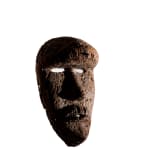Open a larger version of the following image in a popup:
 Untitled, Admire Kamudzengerere
Untitled, Admire Kamudzengerere
 Untitled, Admire Kamudzengerere
Untitled, Admire Kamudzengerere
Open a larger version of the following image in a popup:
 Untitled, Admire Kamudzengerere
Untitled, Admire Kamudzengerere
 Untitled, Admire Kamudzengerere
Untitled, Admire Kamudzengerere
Anonymous Ivory Coast artist
Dan Mask
wood, metal
origin: Ivory Coast - early 20th century
origin: Ivory Coast - early 20th century
21 x 12 x 10 cm
8 1/4 x 4 3/4 x 4 in
8 1/4 x 4 3/4 x 4 in
custom made metal base included
Photo: Valentin Clavairolles
Further images
At the center of the masking traditions in the Dan region was the survival and thriving of the community. Not a single aspect of village life remained untouched by the...
At the center of the masking traditions in the Dan region was the survival and thriving of the community. Not a single aspect of village life remained untouched by the interference of masks. Their wooden face masks did not depict ancestors, neither were they portraits. Masked performers impersonated spirits, connecting humans with the supernatural. These beings occasionally left their hideout in the woods to dispel malign forces from the village and to chastise, exhort, educate, or entertain its inhabitants. As every mask could fulfill different roles within the community, it is impossible to identify the function of a mask based solely on its shape. Moreover, the status and function of these masks could change during the life of their owner. Just as a person could climb the social ladder, so too a mask might ascend in rank. Even after the death of their owner, a mask kept fulfilling a ritual role. It would be placed in a shrine and served as a direct link with the ancestor. Living in the afterworld, he was closer to the supernatural and could exert his influence to bless his descendants. The mask would never dance again and as a shrine object would frequently be coated with libations. Through time those sacrifices interacted with the wooden surface of the mask, resulting in the pitted skin the mask now displays.
Provenance
Collection John Lens, Antwerp, Belgium
By descent through family, 2010
Marcel Nies, Antwerp, Belgium
Sanne Nies, Eindhoven, The Netherlands
Private Collection, Belgium
let's keep in touch
Join our community & never miss out on a DUENDE moment from now on
* denotes required fields
We will process the personal data you have supplied to communicate with you in accordance with our Privacy Policy. You can unsubscribe or change your preferences at any time by clicking the link in our emails.











